[2022年12月] 合格させるVMware 5V0-41.20テストエンジンPDFで完全版無料問題集
VMware SD-WAN Troubleshoot練習テスト2022年最新の5V0-41.20ストレスなしで合格!
質問 19
Scenario 1:
A network administrator is tasked with enabling SD-WAN at three branch locations. A topology has been provided for reference. For each site, the administrator is having issues bringing edges online, as another administrator has gone ahead and created a configuration ahead of lime. The organization has several branch sites. One is an Internet-only site and two are Hybrid locations with both internet and MPLS. The last location is MPLS only. There are hub data center locations in this environment as well. Please refer to the topology.
Exhibit.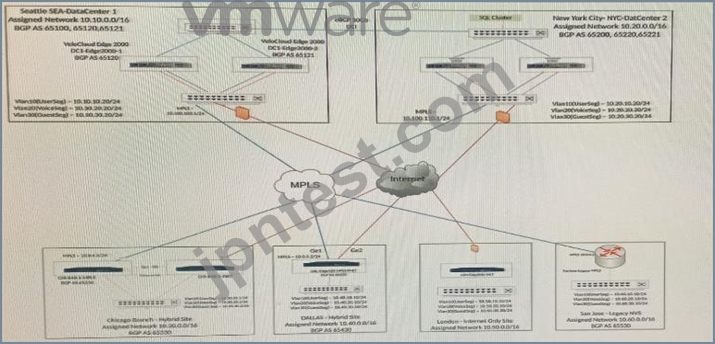
When attempting to activate an Edge, after clicking on the "activation link" in the email that was sent to the network administrator, the Edge's local UI shows as "Internet down". This is preventing the Edge from coming online and being activated. When referring to the output, the network administrator notices that the Edge has received DHCP addressing.
What could be preventing the Edge from coming online?
- A. The Edge's profile does not specify the correct Edge Model.
- B. The next hop does not respond to ICMP pings.
- C. The subnet mask assigned to the Edge is incorrect.
- D. Cloud VPN is not enabled in the AMER Branch profile.
正解: A
質問 20
Scenario 2:
After completing the branch activation activities for ail required branches, the network administrator attempts to test connectivity between the various branches and between the hubs and blanches. The administrator notices a lack of connectivity despite being certain that configurations have been complete. The administrator also observed that several users are reporting intermittent connectivity to some of the applications they are accessing. Other users are reporting no access to these applications. Other users at some of the branches claim they cannot get to certain public resources. The administrator wants to ensure that all sites can talk to each other and all resources are accessible.
Exhibit.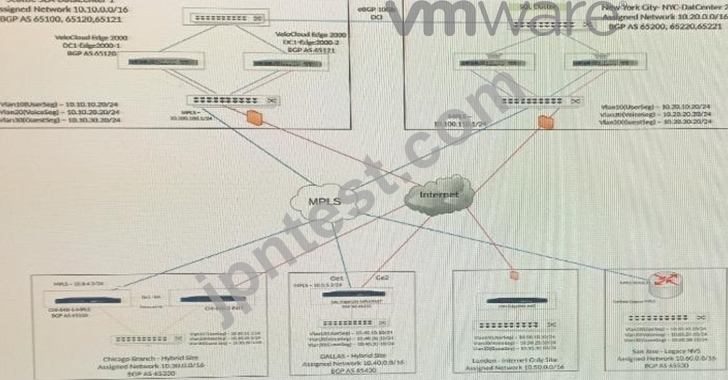
After deploying the Edge, the security team has determined that traffic from Guest wireless traffic is able to reach resources in the Production network. There should be absolutely no interaction.
How can this be prevented?
- A. Segmentation is currently not supported on VeloCloud Edge.
- B. Have Guest wireless and Production traffic in the same segment but different VLANs.
- C. Create two subnets, one for Guest wireless traffic and another one for Production traffic.
- D. Create an additional segment for Guest wireless traffic and leave the Production traffic in the default global segment.
正解: A
質問 21
Scenario 3:
After resolving numerous connectivity issues throughout the various branch sites, connectivity between applications and users is finally present. The network administrator is informed that during certain tests, applications are not performing as they are expected to. Users report that call quality has not fully improved and that some of their calls either drop or have poor voice quality where the conversation is breaking up. Other users are noticing that file transfers are slower than expect. A group of users from a few sites have reported slowness in accessing internal and external applications.
Exhibit.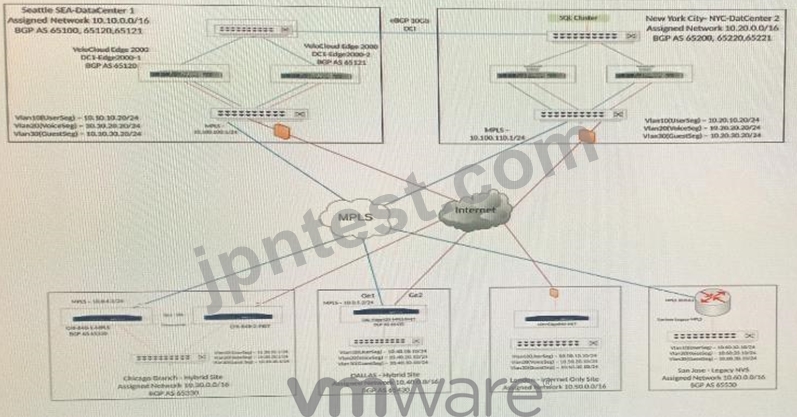
Users at the Dallas Branch are complaining that downloads/uploads from Office365 are slow. Working in Teams has been providing slow responses. The Internet circuit is 100Mbps while the MPLS Circuit is 45Mbps. Upon troubleshooting, the network administrator has noticed the traffic is Backhauling through the Seattle hub for all internet traffic.
How should the network administrator resolve the issue?
- A. Leave the system as is, the hubs will auto-rebalance tunnels after doing 15 minutes of link qualification.
- B. Prevent the hub from advertising a default route.
- C. Leave the system as is, the gateways will resolve the issues after doing 15 minutes of link qualification.
- D. Advertise public routes to Office365 and Teams through the New York Hub.
正解: D
質問 22
Scenario 2:
After completing the branch activation activities for all required branches, the network administrator attempts to test connectivity between the various branches and between the hubs and branches. The administrator notices a lack of connectivity despite being certain that configurations have been complete. The administrator also observed that several users are reporting intermittent connectivity to some of the applications they are accessing. Other users are reporting no access to these applications. Other users at some of the branches claim they cannot get to certain public resources. The administrator wants to ensure that all sites can talk to each other and all resources are accessible.
Exhibit.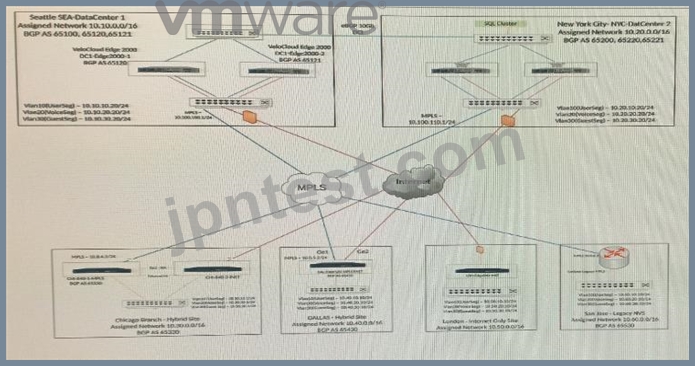
Users at the London site are complaining of various intermittent issues around websites not loading, or applications being remotely accessed disconnecting sporadically and reconnecting after a few minutes. The network administrator does not see anything strange on the Edge overview page and decides to check if the CPU or memory have been hitting close to 100%.
Where should the administrator verify this information?
- A. In the VCO > Monitor > Click London_Site01 > Click the System Tab
- B. In the VCO > Monitor > Alerts
- C. In the VCO > Remote Troubleshooting > Remote Actions > System Status
- D. In the VCO > Test 8c Troubleshoot > Remote Diagnostics > System Status
正解: A
質問 23
Scenario 1:
A network administrator is tasked with enabling SD-WAN at three branch locations. A topology has been provided for reference. For each site, the administrator is having issues bringing edges online, as another administrator has gone ahead and created a configuration ahead of time. The organization has several branch sites. One is an Internet-only site and two are Hybrid locations with both internet and MPLS. The last location is MPLS only. There are hub data center locations in this environment as well. Please refer to the topology.
Exhibit.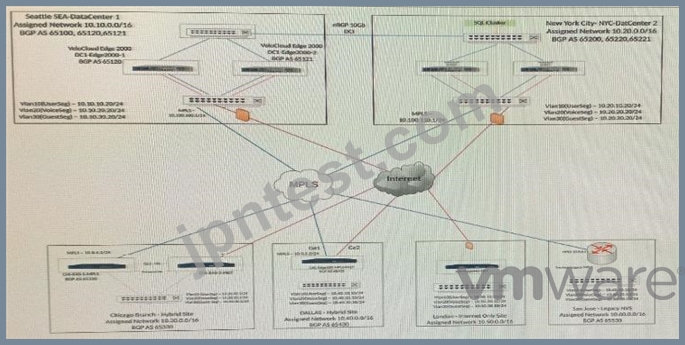
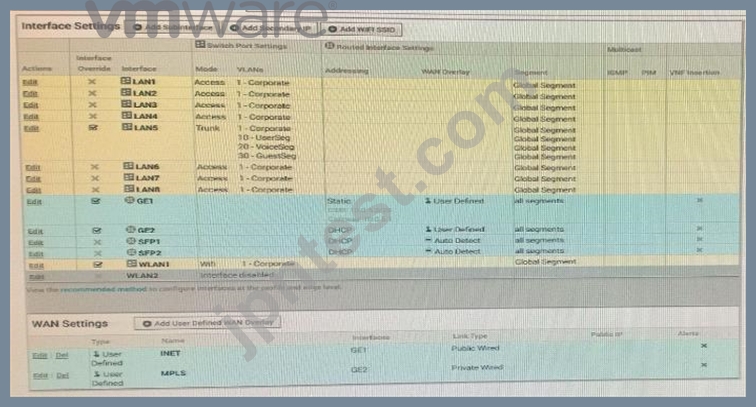
The network administrator determines the issue preventing the Dallas Branch from coming online.
Refer to the Exhibit(s).
What must the administrator do for the Edge to communicate with the Orchestrator and other branches?
- A. Reverse the WAN Overlay configurations
- B. Delete the User Defined WAN Overlays as the Orchestrator will discover these automatically on MPLS and Internet
- C. Update the Orchestrator to the latest version as it enables "Auto WAN Swapping"
- D. Create a User-defined WAN Overlay to bond both interfaces
正解: A
質問 24
Scenario 3:
After completing the branch activation activities for all required branches, the network administrator attempts to test connectivity between the various branches and between the hubs and branches. The administrator notices a lack of connectivity despite being certain that configurations have been complete. The administrator also observed that several users are reporting intermittent connectivity to some of the applications they are accessing. Other users are reporting no access to these applications. Other users at some of the branches claim they cannot get to certain public resources. The administrator wants to ensure that all sites can talk to each other and all resources are accessible.
Exhibit.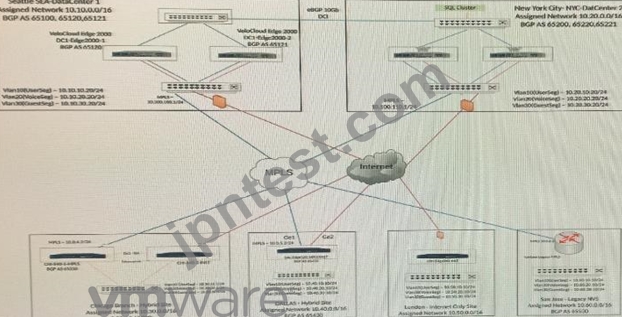
The network administrator determines that dynamic routes to SD-WAN sites are missing at the San Jose branch router. The network administrator decides to look into the configurations of hub Edges. All SD-WAN branch sites must use a hub to communicate with the San Jose site. Best practices have been implemented at these SD-WAN sites.
Where should the administrator check first to verify if the configuration is correct?
- A. Verify that the NVS feature is enabled in Cloud VPN.
- B. Verify the static routes to San Jose from all Branches are configured.
- C. Verify that redistribution between the primary hub site and San Jose is enabled.
- D. Verify that redistribution at the Dallas Hybrid Site is enabled for San Jose to use as a peering point.
正解: B
質問 25
Scenario 3:
After resolving numerous connectivity issues throughout the various branch sites, connectivity between applications and users is finally present. The network administrator is informed that during certain tests, applications are not performing as they are expected to. Users report that call quality has not fully improved and that some of their calls either drop or have poor voice quality where the conversation is breaking up. Other users are noticing that file transfers are slower than expect. A group of users from a few sites have reported slowness in accessing internal and external applications.
Exhibit.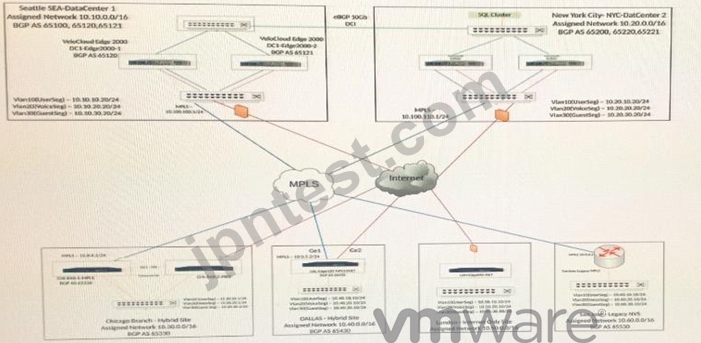
A network administrator is receiving complaints that a real-time voice application is not performing well, with choppy audio, and dead audio especially during peak traffic times.
What two actions can the administrator take to diagnose and fix the issue? (Choose two.)
- A. Ensure that the realtime application is matching the correct application type using the diagnostics page.
- B. Configure a QoS policy to rate limit all traffic during peak times.
- C. Configure a QoS policy to load balance the realtime traffic across all links.
- D. Check the status of the links using the QoE and Transport tabs for any degraded underlay issues or congestion issues.
正解: B,D
質問 26
Scenario 1:
A network administrator is tasked! with enabling SO-WAN at three branch locations. A topology has been provided for reference. For each site, the administrator is having issues bringing edges online, as another administrator has gone ahead and created a configuration ahead of time. The organization has several branch sites- One is an Internet-only site and two are Hybrid locations with both internet and MPLS: The last location is MPLS only. There are hub data center locations in this environment as well. Please refer to the topology.
Exhibit.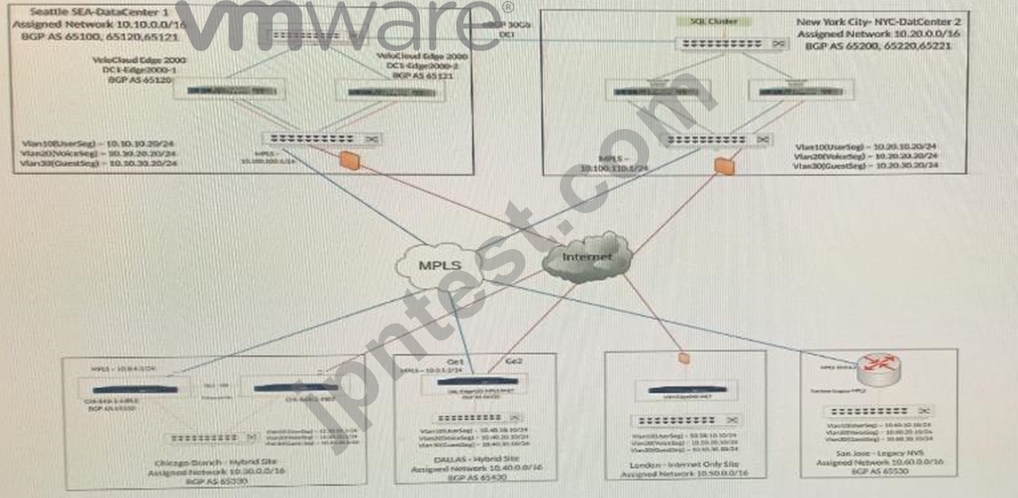
An administrator is attempting to activate two Edge devices at the Chicago branch location. The local technician reports that the Edge devices are not coming online. The Edge devices have been plugged in, powered on, and connected to the correct circuits with an Enhanced HA setup.
What should the local technician check first when troubleshooting the issue?
- A. Review color of the LED.
- B. Verify the link light sequence of the HA ports.
- C. Review the Orchestrator for HA misconfiguration issues.
- D. Verify beep sequence of the Edge devices.
正解: B
質問 27
Scenario 3:
After resolving numerous connectivity issues throughout the various branch sites, connectivity between applications and users is finally present. The network administrator is informed that during certain tests, applications are not performing as they are expected to. Users report that call quality has not fully improved and that some of their calls either drop or have poor voice quality where the conversation is breaking up. Other users are noticing that file transfers are slower than expect. A group of users from a few sites have reported slowness in accessing internal and external applications.
Exhibit.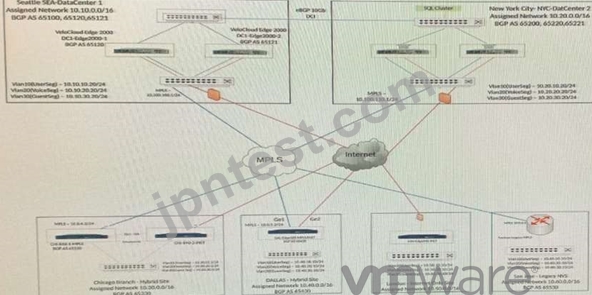
A network engineer is configuring an Internet Backhaul Policy for the Chicago Branch to utilize NY's hub as a much better source for Internet for certain SaaS applications. For an unknown reason, the network engineer is not able to select the hubs in the Internet Backhaul Policy.
What could be the reason?
- A. The hub is not configured with the proper IP address.
- B. The Dynamic Branch to Branch has not been enabled.
- C. Dynamic Branch to Branch using gateways has not been enabled.
- D. The Edge's profile does not include Backhaul hubs as an option.
正解: C
質問 28
Scenario 2:
After completing the branch activation activities for all required branches, the network administrator attempts to test connectivity between the various branches and between the hubs and branches. The administrator notices a lack of connectivity despite being certain that configurations have been complete. The administrator also observed that several users are reporting intermittent connectivity to some of the applications they are accessing. Other users are reporting no access to these applications. Other users at some of the branches claim they cannot get to certain public resources. The administrator wants to ensure that all sites can talk to each other and all resources are accessible.
Exhibit.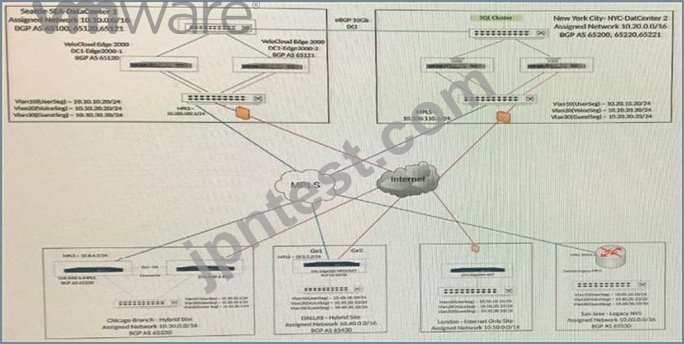
One branch location is not able to communicate with another branch location via dynamic branch-to-branch tunnels. While troubleshooting at the Edge configuration level, the network administrator notices Cloud VPN is not enabled and is grayed out, preventing them from enabling that feature.
- A. Within the Test & Troubleshooting section under Remote Diagnostics.
- B. Within the Configuration section under Customer VPN enablement.
- C. Within the Configuration section under Profiles. Within the Monitor section under Network Services.
- D. Where is the next location to check for and enable the necessary feature?
正解: B
質問 29
Scenario 3:
After resolving numerous connectivity issues throughout the various branch sites, connectivity between applications and users is finally present. The network administrator is informed that during certain tests, applications are not performing as they are expected lo. Users report that call quality has not fully improved and that some of their calls either drop or have poor voice quality where the conversation is breaking up. Other users are noticing that file transfers are slower than expect. A group of users from a few sites have reported slowness in accessing internal and external applications.
Exhibit.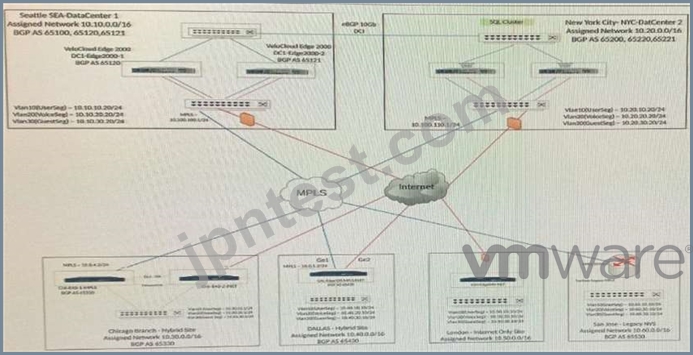
Users are complaining that web pages to certain web sites are very slow to load and at times unresponsive. The network administrator has verified that the traffic is going correctly out the underlay.
What should the administrator check next?
- A. Verify if there is latency, loss, or jitter on the underlay.
- B. Verify if routes to Gateways are present in the Overlay Flow Control (OFC).
- C. Verify if Path-MTU Discovery is disabled.
- D. Verify the Business Policy flows are matching.
正解: C
質問 30
Scenario 3:
After resolving numerous connectivity Issues throughout the various branch sites, connectivity between applications and users is finally present. The network administrator is informed that during certain tests, applications are not performing as they are expected to. Users report that call quality has not fully improved and that some of their calls either drop or have poor voice quality where the conversation is breaking up. Other users are noticing that file transfers are slower than expect. A group of users from a few sites have reported slowness in accessing internal and external applications.
Exhibit.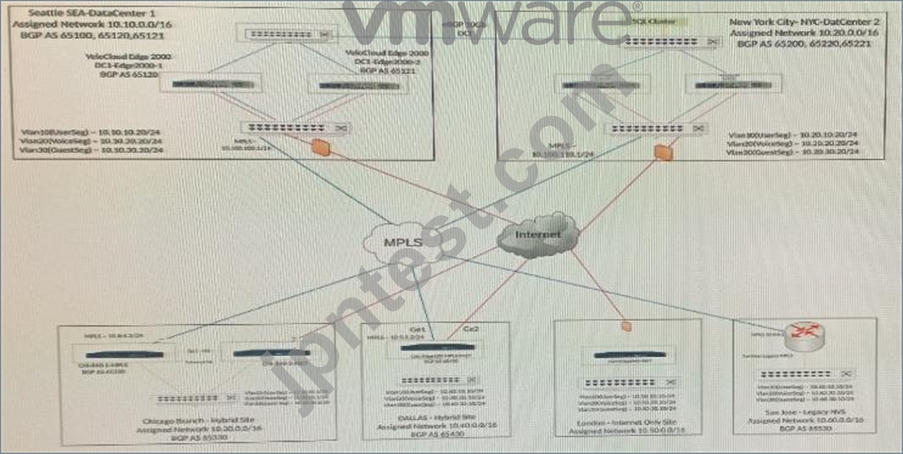
The network administrator has been made aware that Chicago is receiving traffic from non-SD-WAN sites, bottlenecking Chicago's interfaces. The network administrator's VMware SE has mentioned using the uplink feature to help resolve this.
What are two ways the uplink feature should be used in this scenario? (Choose two.)
- A. Stop mutual redistribution of routes from underlay and overlay.
- B. Direct all traffic to that neighbor designated as an uplink,
- C. Set the uplink community to forward traffic to a group of neighbors.
- D. Prevent the site in question from becoming a transit site.
正解: B,D
質問 31
Scenario 2:
After completing the branch activation activities for all required branches, the network administrator attempts to test connectivity between the various branches and between the hubs and branches. The administrator notices a lack of connectivity despite being certain that configurations have been complete. The administrator also observed that several users are reporting intermittent connectivity to some of the applications they are accessing. Other users are reporting no access to these applications. Other users at some of the branches claim they cannot get to certain public resources. The administrator wants to ensure that all sites can talk to each other and all resources are accessible.
Exhibit.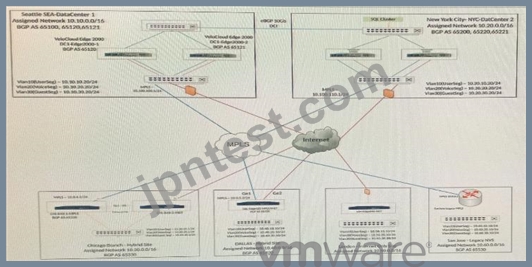
When checking connectivity from the San Jose branch, all users report that they can reach certain resources at the main data center. They are unable to reach locations elsewhere. The network administrator investigates and first looks at the Overlay Flow Control (OFC) Table.
What should the network administrator look for next to determine what the issue might be?
- A. Check with the local network administrator to see if the routes for the SD-WAN sites are present in San Jose's branch router.
- B. Check Test & Troubleshoot and review a route table dump of the NY hub site.
- C. Check the Global Segment Configuration to see if it has the Routing Flag enabled.
- D. Determine if OSPF has been configured on the MPLS Routers at the hub.
正解: C
質問 32
Scenario 2:
After completing the branch activation activities for all required branches, the network administrator attempts to test connectivity between the various branches and between the hubs and branches. The administrator notices a lack of connectivity despite being certain that configurations have been complete. The administrator also observed that several users are reporting intermittent connectivity to some of the applications they are accessing. Other users are reporting no access to these applications. Other users at some of the branches claim they cannot get to certain public resources. The administrator wants to ensure that all sites can talk to each other and all resources are accessible.
Exhibit.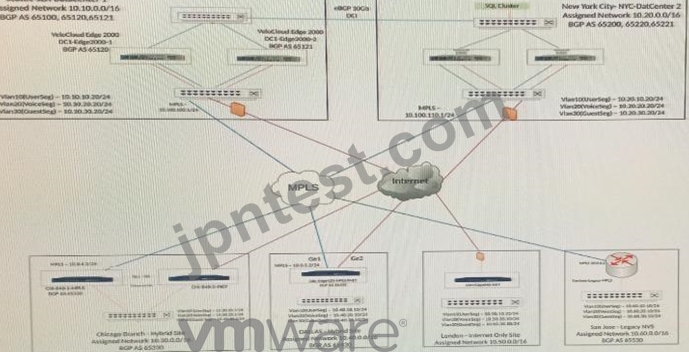
A network administrator is investigating connectivity issues between Chicago and San Jose. The administrator browses to the Overlay Flow Control (OFC) window and notices that the screen is blank with no routes shown in the OFC.
What is a possible reason for this?
- A. Cloud VPN for the Edges / Profiles is not enabled.
- B. OSPF or BGP is not enabled.
- C. The routing table on the Edges has not been initialized.
- D. There is an invalid MTU configuration at Chicago.
正解: A
質問 33
Scenario 2:
After completing the branch activation activities for all required branches, the network administrator attempts to test connectivity between the various branches and between the hubs and branches. The administrator notices a lack of connectivity despite being certain that configurations have been complete. The administrator also observed that several users are reporting intermittent connectivity to some of the applications they are accessing. Other users are reporting no access to these applications. Other users at some of the branches claim they cannot get to certain public resources. The administrator wants to ensure that all sites can talk to each other and all resources are accessible.
Exhibit.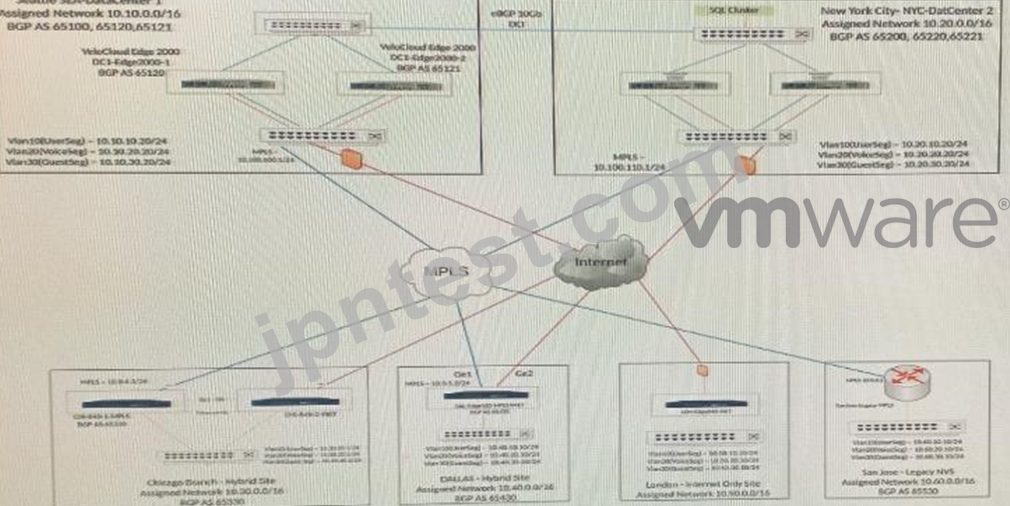
A network administrator decides to deploy a local Checkpoint VNF appliance on the Edge in London to cut back on unnecessary traffic towards the NY Hub location. While attempting to deploy the VNF, the process keeps failing.
Where can the administrator check to see more detail?
- A. VCO > Test & Troubleshoot > Remote Actions > Alerts
- B. VCO > Monitor > Logging
- C. VCO > Test & Troubleshoot > Remote Diagnostics > Events
- D. VCO > Monitor > Events
正解: B
質問 34
Scenario 2:
After completing the branch activation activities for all required branches, the network administrator attempts to test connectivity between the various branches and between the hubs and branches. The administrator notices a lack of connectivity despite being certain that configurations have been complete. The administrator also observed that several users are reporting intermittent connectivity to some of the applications they are accessing. Other users are reporting no access to these applications. Other users at some of the branches claim they cannot get to certain public resources. The administrator wants to ensure that all sites can talk to each other and all resources are accessible.
Exhibit.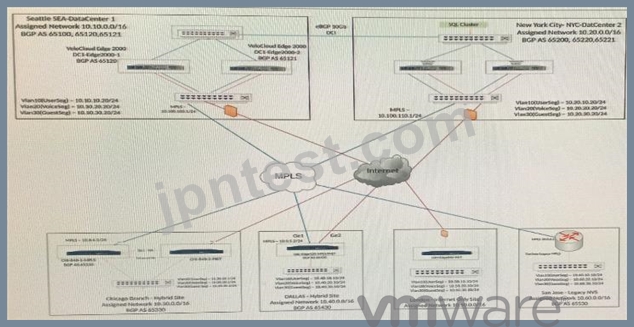
The SD-WAN Edge at this location has been activated. It is incapable of establishing any overlay tunnels. Due to this being an internet only branch, no underlay connectivity is present to the hubs. The SD-WAN Edge is connected behind a firewall and the security team states that all necessary ports are open.
How can this issue be resolved?
- A. The security team need to open TCP port 2426 outbound but not inbound.
- B. The security team needs to open TCP port 4500 instead of TCP port 2426.
- C. The security team needs to open UDP port 2426 outbound and inbound.
- D. The security team needs to open TCP port 22 instead of TCP port 2426.
正解: C
質問 35
Scenario 3:
After resolving numerous connectivity issues throughout the various branch sites, connectivity between applications and users is finally present. The network administrator is informed that during certain tests, applications are not performing as they are expected to. Users report that call quality has not fully improved and that some of their calls either drop or have poor voice quality where the conversation is breaking up. Other users are noticing that file transfers are slower than expect. A group of users from a few sites have reported slowness in accessing internal and external applications.
Exhibit.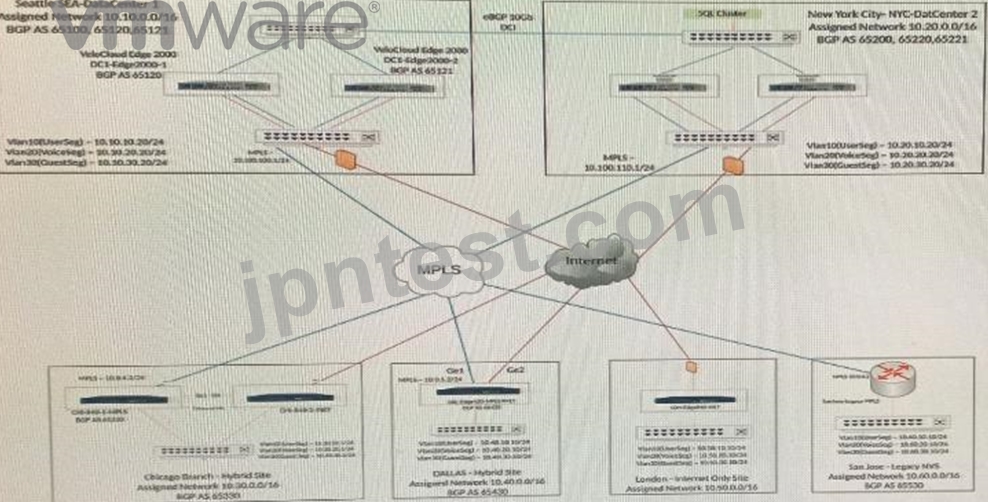
A network administrator decides to deploy a local Checkpoint VNF appliance on the Edge in London to cut back on unnecessary traffic towards the NY hub location.
The Checkpoint VNF and associated security services were successfully deployed at the London Branch. Users are now are complaining that Webpages are extremely slow to load, just like before.
What should the administrator do?
- A. Disable and redeploy the VNF with lower memory requirements.
- B. Verify to see if a firewall rule in the Edge is set to allow traffic to the Checkpoint VNF.
- C. Check the flow records in Remote Diagnostics.
- D. Reboot the Edge, as this is a requirement in the deployment of a Security VNF.
正解: A
質問 36
Scenario 3:
After resolving numerous connectivity issues throughout the various branch sites, connectivity between applications and users is finally present. The network administrator is informed that during certain tests, applications are not performing as they are expected to. Users report that call quality has not fully improved and that some of their calls either drop or have poor voice quality where the conversation is breaking up. Other users are noticing that file transfers are slower than expect. A group of users from a few sites have reported slowness in accessing; internal and external applications.
Exhibit.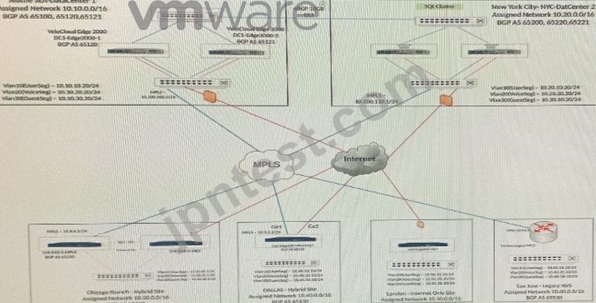
A network administrator is configuring several branches to prefer a single prefix, 10.20.11.0/24, from the Seattle hub over the New York hub for various application performance reasons.
What are two effective ways the administrator can accomplish this? (Choose two.)
- A. Modify the AS Path in New York to be longer for 10.20.11.0/24.
- B. In the OFC 10.20.11.0/24, modify the preferred exit point to be Seattle and pin the route.
- C. Modify the AS Path in New York to be shorter for 10.20.11.0/24.
- D. In the hub preferred order in the profile, set the Seattle hub to be preferred over New York.
正解: B,D
質問 37
Scenario 2:
After completing the branch activation activities for all required branches, the network administrator attempts to test connectivity between the various branches and between the hubs and branches. The administrator notices a lack of connectivity despite being certain that configurations have been complete. The administrator also observed that several users are reporting intermittent connectivity to some of the applications they are accessing. Other users are reporting no access to these applications. Other users at some of the branches claim they cannot get to certain public resources. The administrator wants to ensure that all sites can talk to each other and all resources are accessible.
Exhibit.
One branch location is not able to communicate with another branch location via dynamic branch-to-branch tunnels. While troubleshooting at the Edge configuration level, the network administrator notices Cloud VPN is not enabled and is grayed out, preventing them from enabling that feature.
- A. Within the Test & Troubleshooting section under Remote Diagnostics.
- B. Within the Configuration section under Customer VPN enablement.
- C. Within the Configuration section under Profiles. Within the Monitor section under Network Services.
- D. Where is the next location to check for and enable the necessary feature?
正解: B
質問 38
Scenario 3:
After resolving numerous connectivity issues throughout the various branch sites, connectivity between applications and users is finally present. The network administrator is informed that during certain tests, applications are not performing as they are expected lo. Users report that call quality has not fully improved and that some of their calls either drop or have poor voice quality where the conversation is breaking up. Other users are noticing that file transfers are slower than expect. A group of users from a few sites have reported slowness in accessing internal and external applications.
Exhibit.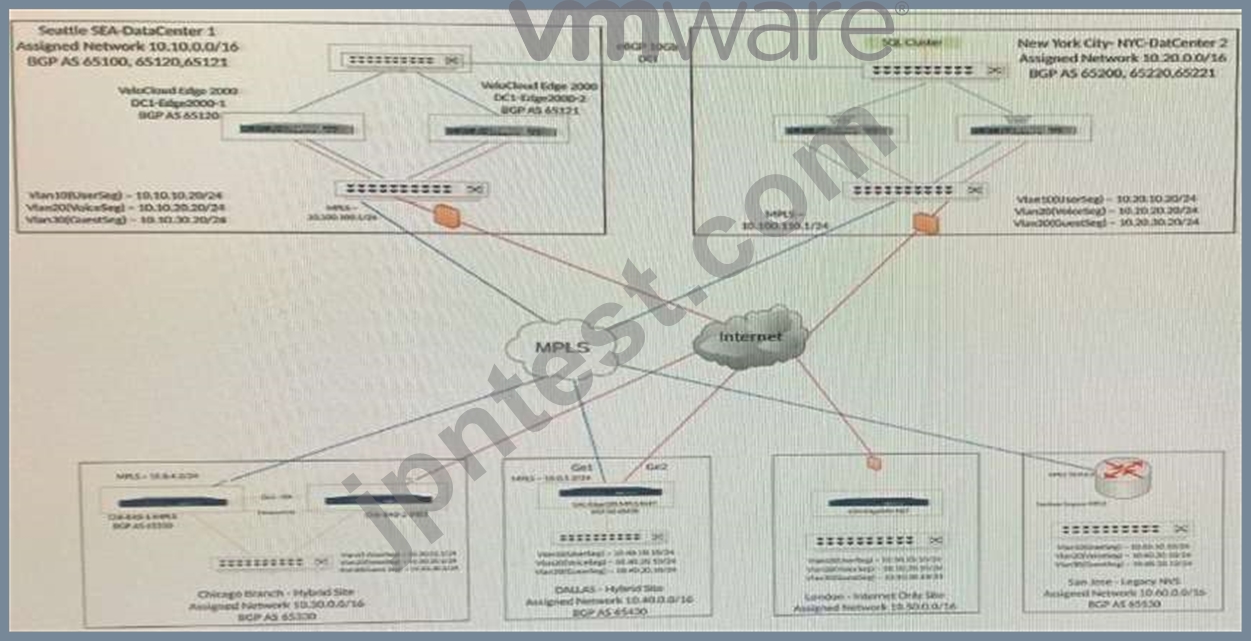
Users are complaining that web pages to certain web sites are very slow to load and at times unresponsive. The network administrator has verified that the traffic is going correctly out the underlay.
What should the administrator check next?
- A. Verify if there is latency, loss, or jitter on the underlay.
- B. Verify if routes to Gateways are present in the Overlay Flow Control (OFC).
- C. Verify if Path-MTU Discovery is disabled.
- D. Verify the Business Policy flows are matching.
正解: C
質問 39
Scenario 1:
A network administrator is tasked with enabling SO-WAN at three branch locations. A topology has been provided for reference. For each site, the administrator is having issues bringing edges online, as another administrator has gone ahead and created a configuration ahead of time. The organization has several branch sites. One is an Internet-only site and two are Hybrid locations with both internet and MPLS. The last location is MPLS only. There are hub data center locations in this environment as well. Please refer to the topology.
After the network administrator has determined the problem with the Edge not being able to access the Internet, the administrator receives another error stating that the SD-WAN Orchestrator is still not reachable.
The VCO's address is Amer-vcoOl.velocloud.net.
Refer to the Exhibit(s).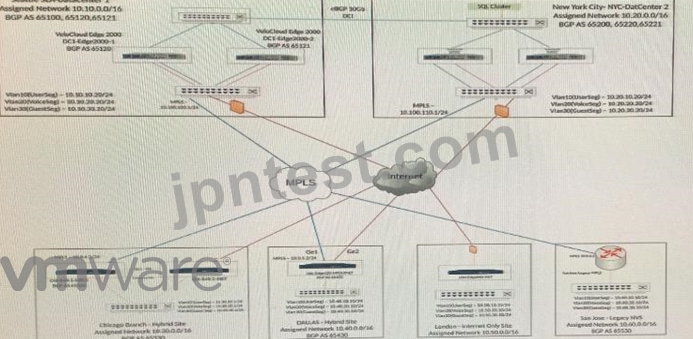
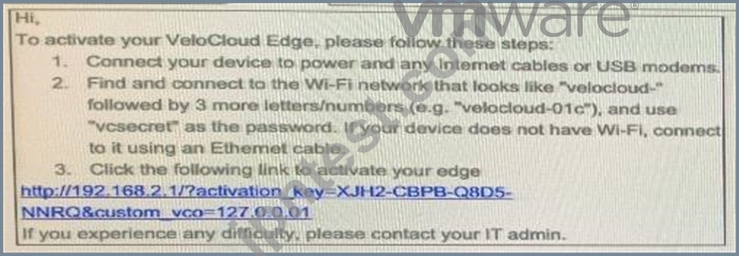
What might be disallowing the Edge to communicate with the Orchestrator?
- A. The SD-WAN Orchestrator is not being resolved for DNS.
- B. The local firewall that the Edge uses to reach externally is blocking UDP Port 53 in both directions.
- C. The SD-WAN Orchestrator specified is incorrect, and a new activation email needs to be sent.
- D. The SD-WAN Orchestrator has a limited 60-second window for the Edge to come online.
正解: D
質問 40
Scenario 1:
The Dallas Branch location is having issues getting activated. The local network administrator is aware that the Edge device received a DHCP address and was able to connect to the internet. The Orchestrator is reporting the Edge as Down. No other changes were made post activation.
A network administrator is tasked with enabling SD-WAN at three branch locations. A topology has been provided for reference. For each site, the administrator is having issues bringing edges online, as another administrator has gone ahead and created a configuration ahead of time. The organization has several branch sites. One is am Internet-only site and two are Hybrid locations with both internet and MPLS. The last location is MPLS only. There are hub data center locations in this environment as well. Please refer to the topology.
Refer to the Exhibit(s).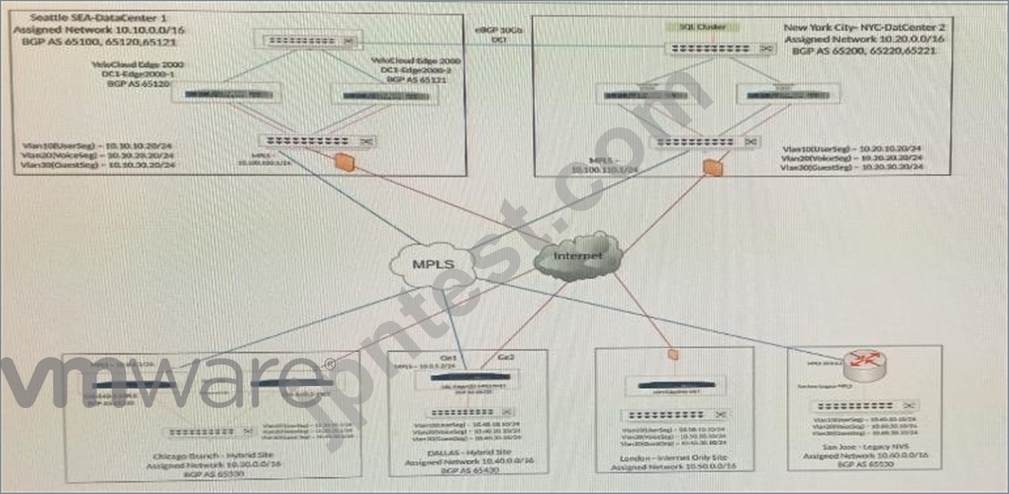
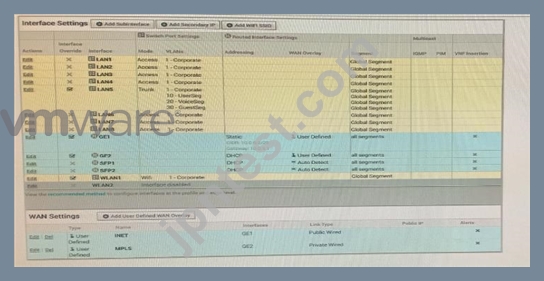
What is the cause of this issue?
- A. The activation link did not specify the updated image location requiring the Edge to be re-activated.
- B. The Edge will be offline for about 4 hours until it has completed the factory image installation.
- C. The activation link contained incorrect configurations for WAN overlays and WAN interfaces.
- D. The activation link did not contain any post-activation configuration to allow the Orchestrator to communicate with the Edge.
正解: A
質問 41
......
オンライン試験練習テストと詳細な解説付き!:https://www.jpntest.com/shiken/5V0-41.20-mondaishu
